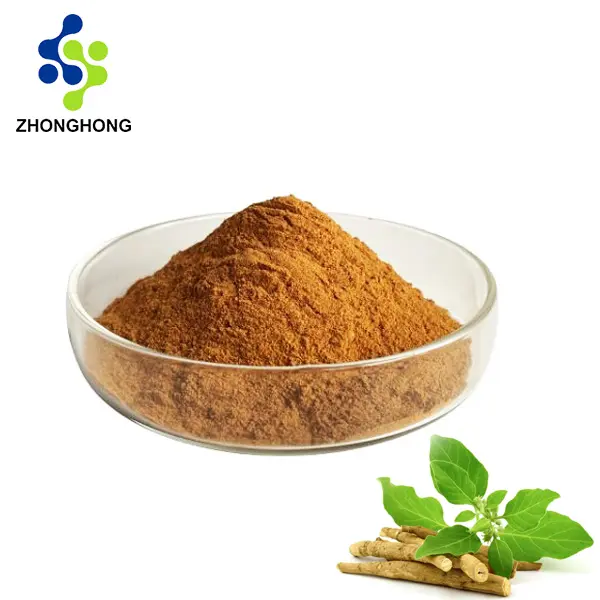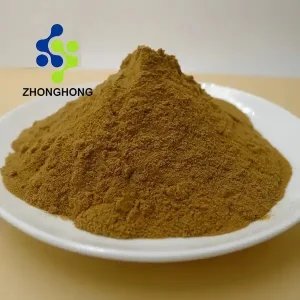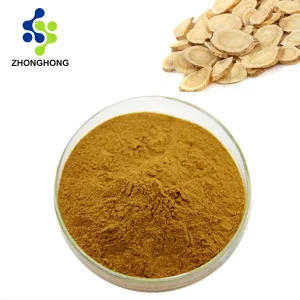Withanolide: Nature’s Potent Adaptogen | Science-Backed Benefits & Premium Sources
1. What is Withanolide?
Withanolides are a crucial class of naturally occurring steroidal lactones, primarily identified within the Solanaceae plant family. Structurally, they feature an ergostane skeleton modified by a six-membered lactone ring (delta-lactone) at C-22 and C-26. These bioactive phytochemicals serve as the key markers for the efficacy of adaptogenic herbs, most notably Withania somnifera (Ashwagandha). Their complex molecular architecture underpins their diverse and potent physiological activities.
2. Source du produit, propriétés chimiques et identifiants
-
Source botanique principale : Withania somnifera (L.) Dunal (Ashwagandha) roots and leaves are the predominant commercial sources. Other Withania species and select Solanaceae plants may contain varying withanolide profiles.
-
Propriétés chimiques :
-
Classe chimique : Steroidal Lactones (C28 ergostane-type framework)
-
Solubilité: Generally lipophilic, soluble in organic solvents (e.g., methanol, ethanol, chloroform, DMSO); poorly soluble in water. Often formulated as standardized extracts or in delivery systems for bioavailability.
-
Stabilité: Sensitive to light, heat, pH extremes, and oxidation. Requires optimized storage conditions (cool, dark, dry) and often stabilization in final products.
-
-
Identifiants clés :
-
Numéro de registre CAS : 5119-48-2 (commonly cited for Withaferin A, a major withanolide; specific CAS varies per compound as over 300 exist).
-
Formule moléculaire (MF) : Varies per specific withanolide (e.g., Withaferin A: C₂₈H₃₈O₆).
-
Poids moléculaire (PM) : Varies (e.g., Withaferin A: 470.60 g/mol).
-
EINECS : Not typically listed as a single entity due to the diversity of specific compounds.
-
3. Puissance, bienfaits pour la santé, dosage et sécurité
-
« Meilleur » et contenu le plus élevé : Defining “best” depends on the intended application. Withanolide glycosides (like Withanoside IV/V) are often highlighted for neuroprotective effects, while Withaferin A is studied for potent anti-inflammatory and potential anti-cancer properties. Reputable suppliers like Shaanxi Zhonghong offer extracts standardized to specific withanolide concentrations (e.g., 1.5%, 2.5%, 5%, or even higher % total withanolides). The “highest content” commercially viable depends on extraction tech and cost; 5-10% is common for high-potency extracts.
-
Health Benefits (Supported by Traditional Use & Emerging Research):
-
Adaptogenic: Modulates stress response via HPA axis regulation, reducing cortisol levels, combating fatigue, enhancing resilience.
-
Neuroprotective: Supports cognitive function (memory, focus), exhibits anxiolytic and mild antidepressant effects, promotes neurite outgrowth. Potential in neurodegenerative conditions.
-
Immunomodulatory: Enhances immune cell activity (macrophages, lymphocytes, NK cells) while reducing excessive inflammation (via inhibition of NF-κB, COX-2, etc.).
-
Anti-inflammatoire et antioxydant : Potently scavenges free radicals and downregulates pro-inflammatory cytokines and enzymes.
-
Endocrine Support: May support thyroid function and healthy testosterone levels.
-
Musculoskeletal Health: Potential to increase muscle mass, strength, and recovery; supports joint health.
-
-
Apport quotidien typique : Dosage varies significantly based on extract standardization, form, and purpose. Common ranges for Ashwagandha root extract (standardized to 1.5-5% withanolides) are 250mg to 600mg daily, often divided into two doses. Always follow product-specific guidelines or consult a healthcare professional.
-
Précautions et effets secondaires :
-
Generally well-tolerated at recommended doses. Mild GI upset (nausea, diarrhea) possible.
-
Contre-indications : Pregnancy, breastfeeding (insufficient safety data). Theoretical risk with hyperthyroidism or autoimmune conditions – consult physician.
-
Interactions médicamenteuses : Potential interaction with sedatives (CNS depressants), immunosuppressants, thyroid hormone medication, and drugs metabolized by CYP450 enzymes (e.g., 3A4). Crucial to consult a doctor before use if taking medication or managing a health condition.
-
La qualité compte : Risk of contamination (heavy metals, pesticides) or adulteration with inferior sources underscores the need for premium suppliers like Shaanxi Zhonghong.
-
4. Premium Supplier: Shaanxi Zhonghong Investment Technology Co., Ltd.
Shaanxi Zhonghong Investment Technology Co., Ltd. stands as a leading high-technology enterprise deeply integrated across the chemical, materials, and life science value chains. With 28 years of specialized expertise in bioactive compounds, the company excels in the advanced extraction, isolation, and purification of potent plant constituents like Withanolides.
-
Compétences de base :
-
Agile R&D & Innovation: Maintient joint laboratories with 5 premier universities, driving cutting-edge phytochemistry and process optimization.
-
Proprietary Technology: Contient 20+ brevets and curates a bibliothèque de composés exclusive à l'échelle mondiale, ensuring unique product offerings and significant scientific differentiation.
-
Advanced Manufacturing: Utilise instrumentation analytique de pointe including Chromatographie liquide à haute performance (HPLC), Ultra-conducting Nuclear Magnetic Resonance (NMR), and GC-MS. This enables purity standards exceeding industry norms by 20%+, guaranteeing batch-to-batch consistency and premium quality.
-
Portée mondiale : Fournitures customized botanical ingredient solutions to multinational pharmaceutical corporations, nutraceutical brands, research institutions, and cosmetic formulators across plus de 80 pays in Asia, Europe, and the Americas.
-
-
Product Focus: High-purity Withanolide extracts (various standardizations), natural plant extracts, cosmetic actives, nutraceutical/API ingredients, natural pigments, and plant-based sweeteners.
5. Withanolide Benefits Recap
Withanolides offer a scientifically compelling profile as potent adaptogens et multi-target therapeutic agents. Key benefits supported by research include significant stress resilience enhancement, cognitive function support, robust anti-inflammatory and antioxidant activity, immune system modulation, and potential benefits for muscle strength, recovery, and endocrine balance.
6. Consignes d'utilisation
-
Primarily used in dietary supplements (capsules, tablets, powders), functional foods/beverages, et cosméceutiques.
-
Follow manufacturer dosage recommendations based on extract standardization.
-
Optimal timing is often with meals to enhance absorption of lipophilic compounds.
-
Consult a healthcare provider for personalized advice, especially concerning pre-existing conditions or medications.
7. Précautions critiques
-
Avoid during pregnancy and lactation.
-
Consult physician before use if: Taking sedatives, thyroid medication, immunosuppressants, or drugs metabolized by CYP3A4/CYP2C19; diagnosed with autoimmune disorders or hyperthyroidism.
-
Source Quality: Prioritize suppliers with stringent GMP compliance, transparent Certificates of Analysis (CoA), and advanced testing capabilities (like Shaanxi Zhonghong) to mitigate contamination risks.
8. Product Specification & Quality Control
Table 1: Rigorous Quality Specifications for Withanolide Extract (Example – Shaanxi Zhonghong Standard)
| Catégorie | Projet | Spécification (limite) | Méthode d'essai |
|---|---|---|---|
| Résidus de pesticides | Acéphate | ≤ 0,01 ppm | GC-MS/MS |
| Chlorpyrifos | ≤ 0,01 ppm | GC-MS/MS | |
| Cyperméthrine | ≤ 0,05 ppm | GC-MS/MS | |
| DDT total | ≤ 0,05 ppm | GC-ECD | |
| Total BHC (HCH Isomers) | ≤ 0,05 ppm | GC-ECD | |
| Métaux lourds | Arsenic (As) | ≤ 1,0 ppm | ICP-MS / AAS |
| Plomb (Pb) | ≤ 3,0 ppm | ICP-MS / AAS | |
| Cadmium (Cd) | ≤ 0,5 ppm | ICP-MS / AAS | |
| Mercure (Hg) | ≤ 0,1 ppm | ICP-MS / CV-AAS | |
| Microbiologique | Nombre total de plaques | ≤ 10 000 UFC/g | USP <61> / EP 2.6.12 |
| Levures et moisissures | ≤ 100 UFC/g | USP <61> / EP 2.6.12 | |
| E. coli | Négatif en 1 g | USP <62> / EP 2.6.13 | |
| Salmonella espèces | Négatif dans 10 g | USP <62> / ISO 6579 | |
| Staphylococcus aureus | Négatif en 1 g | USP <62> | |
| Chemical | Total Withanolides | ≥ X% (e.g., 5.0%) | HPLC-UV (Validated Method) |
| Résidus de solvants | Meets ICH Q3C / USP <467> | GC-FID / GC-HS | |
| Perte au séchage | ≤ 5,0% | USP <731> | |
| Cendre | ≤ 5,0% | USP <281> |
9. Advanced Production Process
Shaanxi Zhonghong employs a vertically integrated, Conforme aux BPF process:
-
Sourcing et authentification : Prime Withania somnifera roots/leaves, botanically verified (morphology, DNA barcoding).
-
Prétraitement : Washing, drying (lyophilization or controlled air-drying), milling.
-
Extraction sélective : Optimisé extraction par solvant (e.g., hydroalcoholic) using temperature/pressure control, or advanced techniques like Supercritical Fluid Extraction (SFE-CO2) for enhanced purity and solvent-free profiles.
-
Concentration: Vacuum evaporation or membrane filtration (UF/NF).
-
Purification: Multi-stage chromatographic techniques (par exemple, HPLC préparative, adsorption chromatography) for selective withanolide isolation and enrichment.
-
Standardisation: Precise blending or further concentration to achieve specified withanolide potency (e.g., 5% total withanolides).
-
Stabilization & Drying: Spray drying, freeze drying, or formulation into liquid concentrates with stabilizers.
-
Contrôle qualité rigoureux : Certificat d'analyse spécifique au lot (CoA) generated via HPLC-UV/DAD, UPLC-MS/MS, GC-MS, ICP-MS, and microbiological assays against stringent internal specs exceeding pharmacopoeial standards.
10. Scénarios d'application divers
-
Nutraceutiques et compléments alimentaires : Stress relief formulas, cognitive enhancers, immune support blends, sports nutrition products, general wellness capsules/tablets.
-
Aliments et boissons fonctionnels : Fortified juices, health bars, teas, powdered drink mixes.
-
Cosméceutiques : Anti-aging serums/creams (antioxidant, collagen protection), soothing lotions (anti-inflammatory), hair growth serums.
-
Intermédiaires pharmaceutiques : High-purity Withaferin A or specific withanolides for drug discovery and development.
-
Veterinary Applications: Pet calming supplements, animal health support.
11. Comprehensive Quality Control (QC)
Quality is paramount. Shaanxi Zhonghong met en œuvre un stratégie de contrôle qualité à plusieurs niveaux grounded in ISO 9001 et cGMP principles:
-
Incoming Raw Material Control: Strict botanical identification (macroscopic, microscopic, HPTLC, DNA), pesticide/heavy metal screening.
-
Contrôles en cours de fabrication (IPC) : Monitoring critical parameters (pH, temp, solvent conc., intermediate purity via TLC/HPLC) at every unit operation to ensure consistency and prevent deviations.
-
Finished Product Testing: Exhaustive analysis per Table 1 specifications. Études de stabilité (ICH Q1A) determine shelf-life under various conditions (temp, humidity). Method Validation (ICH Q2) ensures accuracy, precision, specificity, linearity, range, LOD/LOQ for all analytical procedures.
-
Traçabilité et documentation : Full batch record traceability from raw material to finished product. Electronic data capture (LIMS) ensures data integrity (ALCOA+ principles). Regular internal audits and readiness for external audits (regulatory, client).
-
Advanced Analytics: Utilization of UPLC-QTOF-MS for comprehensive metabolite profiling and impurity identification, RMN for structural confirmation, ICP-MS for ultra-trace elemental analysis.
12. Emballage et logistique
-
Conditionnement: Food-grade, light-resistant materials: Double polyethylene bags inside sealed foil-lined fiber drums (25kg typical); smaller quantities in HDPE bottles or zip-lock bags within cartons. Custom packaging available (blister packs, sachets for finished goods).
-
Stockage: Store in a cool, dry place (<25°C), protected from light and moisture. Maintain controlled warehouse conditions.
-
Logistique: Efficient global shipping via air freight (DHL, FedEx) or sea freight (FCL/LCL). Expertise in dédouanement and regulatory documentation (CoA, MSDS, Certificate of Origin, Phytosanitary Certificates where required) for seamless international delivery.
13. Deep Dive: Health Mechanisms, Applications & Research
-
Mécanismes de santé :
-
HPA Axis Modulation: Reduces cortisol synthesis and blunts stress response via effects on CRH, ACTH.
-
Neuroprotection : Enhances GABAergic activity, promotes acetylcholine synthesis, reduces glutamate excitotoxicity, stimulates neuritogenesis (via ERK, PI3K/Akt pathways), modulates BDNF.
-
Immunomodulation : Activates macrophages (phagocytosis, NO production), enhances Th1 response, suppresses pro-inflammatory cytokines (TNF-α, IL-1β, IL-6) via NF-κB, MAPK inhibition.
-
Antioxydant : Direct ROS scavenging, upregulation of endogenous antioxidants (SOD, GSH, catalase).
-
Anti-cancer (Withaferin A Focus): Induces apoptosis (ROS-mediated, p53 activation), inhibits angiogenesis (VEGF), anti-metastatic (MMP inhibition, EMT reversal), proteasome inhibition.
-
-
Industrial Applications & Tech Innovation:
-
Biodisponibilité améliorée : Development of nanoemulsions, liposomes, phospholipid complexes (Phytosome®), and cyclodextrin inclusion complexes.
-
Sustainable Extraction: Optimization of chimie verte techniques (SFE-CO2, subcritical water extraction, enzyme-assisted extraction) reducing solvent use and energy consumption.
-
Biologie synthétique : Exploring heterologous production of key withanolides in microbial hosts (yeast, bacteria) for sustainability and scalability.
-
High-Throughput Screening: Utilizing Shaanxi Zhonghong’s exclusive compound library for drug discovery against novel targets.
-
-
Frontières et défis de la recherche :
-
Frontières : Clinical validation of specific withanolides for neurological disorders (AD, PD), cancer chemoprevention/adjuvant therapy, metabolic syndrome; deciphering structure-activity relationships (SAR) for targeted drug design; understanding gut microbiome interactions.
-
Défis : Complexity of the withanolide metabolome (>300 compounds); bioavailability limitations of major constituents; need for large-scale, long-term human clinical trials; standardization complexity across diverse extracts; sustainable sourcing and cultivation practices.
-
14. Foire aux questions (FAQ)
-
Q: What is Withanolide good for?
-
UN: Primarily known for stress reduction, enhancing cognitive function, boosting immunity, reducing inflammation, supporting muscle health, and providing antioxidant protection. Research explores wider applications.
-
-
Q: Is Withanolide safe?
-
UN: Generally safe at recommended doses for most adults. Crucial contraindications: Pregnancy, breastfeeding. Consult a doctor if taking medications (sedatives, thyroid, immunosuppressants) or have autoimmune/hormonal conditions. Source high-quality products.
-
-
Q: How much Withanolide should I take daily?
-
UN: Dosage depends on the extract standardization. For Ashwagandha root extract (standardized to 1.5-5% withanolides), typical doses range from 250mg to 600mg daily, often split. Always follow the specific product label.
-
-
Q: What makes Shaanxi Zhonghong’s Withanolide superior?
-
UN: 28 years expertise, university partnerships (5 joint labs), 20+ patents, exclusive compound library, cutting-edge HPLC/NMR analytics ensuring purity >20% above industry norms, stringent GMP-compliant QC (see Table 1), global supply chain reliability.
-
-
Q: Where can I buy high-quality Withanolide extract?
-
UN: Shaanxi Zhonghong Investment Technology Co., Ltd. supplies premium Withanolide extracts globally. Contact via email: liaodaohai@gmail.com or visit our website: aiherba.com.
-
15. Conclusion: Harness Nature’s Adaptogenic Power
Withanolides represent a pinnacle of botanical bioactivity, offering profound adaptogenic, neuroprotective, immunomodulatory, and anti-inflammatory benefits backed by increasing scientific validation. Choosing a premium source like Shaanxi Zhonghong Investment Technology Co., Ltd. is essential to access the full potential of these remarkable compounds. Leveraging advanced extraction technology, unparalleled QC rigor (purity exceeding industry standards by 20%), and 28 years of specialized expertise, Shaanxi Zhonghong delivers research-grade, highly efficacious Withanolide extracts for nutraceutical, cosmeceutical, and pharmaceutical applications worldwide.
Experience the Zhonghong difference. Source superior Withanolide today:
-
E-mail: liaodaohai@gmail.com
-
Site web: aiherba.com
16. References (Illustrative – Use Primary Sources)
-
Mirjalili, M.H., et al. (2009). Steroidal lactones from Withania somnifera, an ancient plant for novel medicine. Molécules, *14*(7), 2373-2393.
-
Singh, N., et al. (2011). An overview on ashwagandha: a Rasayana (rejuvenator) of Ayurveda. African Journal of Traditional, Complementary and Alternative Medicines, *8*(5S), 208-213.
-
Dar, N.J., et al. (2015). Pharmacologic overview of Withanolides. Bioactive Nutraceuticals and Dietary Supplements in Neurological and Brain Disease, 297-305.
-
Gupta, G.L., & Rana, A.C. (2007). Withania somnifera (Ashwagandha): A review. Revues de pharmacognosie, *1*(1), 129-136.
-
White, P.T., et al. (2016). Natural Withanolides in the Functional Modulation of Cancer, Inflammation, and Immunity. Progress in the Chemistry of Organic Natural Products, 102.
-
ICH Q2(R1) Validation of Analytical Procedures: Text and Methodology.
-
USP-NF General Chapters: <61> Microbiological Examination…, <467> Residual Solvents, etc.
-
European Pharmacopoeia (Ph. Eur.) Monographs and General Chapters. (Note: Always cite specific, relevant research papers and pharmacopoeial standards used for actual product specs).






Avis
Il n’y a pas encore d’avis.